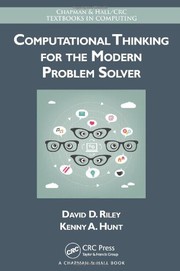Check nearby libraries
Buy this book

This edition doesn't have a description yet. Can you add one?
Check nearby libraries
Buy this book

Showing 4 featured editions. View all 4 editions?
| Edition | Availability |
|---|---|
|
1
Computational Thinking for the Modern Problem Solver
2014, Taylor & Francis Group
in English
1466587814 9781466587816
|
zzzz
Libraries near you:
WorldCat
|
|
2
Computational Thinking for the Modern Problem Solver
2014, Taylor & Francis Group
in English
1466587792 9781466587793
|
zzzz
Libraries near you:
WorldCat
|
|
3
Computational Thinking for the Modern Problem Solver
2014, Taylor & Francis Group
in English
0429167938 9780429167935
|
zzzz
Libraries near you:
WorldCat
|
|
4
Computational thinking for the modern problem solver
2014, CRC Press
in English
1466587776 9781466587779
|
aaaa
Libraries near you:
WorldCat
|
Book Details
Table of Contents
Machine generated contents note: 1.1.Computers, Computers Everywhere
1.2.Computer, Computer Science, And Computational Thinking
1.3.From Abacus To Machine
1.4.The First Software
1.5.What Makes It A Modern Computer?
1.6.The First Modern Computer
1.7.Moore's Law
1.8.Summary
1.9.When Will You Ever Use This Stuff?
References
Terminology
Exercises
2.1.Information And Data
2.2.Converting Information Into Data
2.3.Data Capacity
2.4.Data Types And Data Encoding
2.4.1.Numbers
2.4.1.1.Numeral Systems
2.4.1.2.Positional Numeral System
2.4.1.3.Integers As Binary Bit Strings
2.4.1.4.Real Numbers As Binary Bit Strings
2.4.1.5.Precision As A Source Of Error
2.4.1.6.Underflow And Overflow As Sources Of Error
2.4.2.Text
2.4.3.Colors
2.4.4.Pictures
2.4.5.Sound
2.5.Data Compression
2.5.1.Run-Length Encoding
2.6.Summary
Reference
Terminology
Exercises
3.1.What Is Logic?
3.2.Boolean Logic
Contents note continued: 3.2.1.Writing Well-Formed Propositions
3.2.2.Evaluating Propositions
3.2.2.1.Conjunction (And)
3.2.2.2.Disjunction (Or)
3.2.2.3.Implication (Implies)
3.2.2.4.Equivalence (E)
3.2.2.5.Logical Negation (Not)
3.2.2.6.Compound Propositions
3.2.2.7.Logical Equivalence
3.2.2.8.Tautologies And Contradictions
3.3.Applications Of Propositional Logic
3.3.1.Search Queries
3.3.1.1.Conjunction In Search Queries
3.3.1.2.Disjunction In Search Queries
3.3.1.3.Negation In Search Queries
3.3.2.Digital Logic
3.3.3.Image Compositing
3.3.4.Database Queries
3.3.5.Software Requirements
Terminology
Exercises
4.1.Problem Definition
4.2.Logical Reasoning
4.3.Decomposition: Software Design
4.4.Decomposition: Other Uses
4.5.Abstraction: Class Diagrams
4.6.Abstraction: Use Case Diagrams
4.7.Summary
4.8.When Will You Ever Use This Stuff?
References
Terminology
Exercises
5.1.Algorithms
Contents note continued: 5.2.Software And Programming Languages
5.3.Actions
5.3.1.Name Binding
5.3.1.1.Proper Naming
5.3.1.2.State
5.3.2.Selection
5.3.2.1.One-Way Selection
5.3.2.2.Two-Way Selection
5.3.2.3.Multiway Selection
5.3.3.Repetition
5.3.3.1.Infinite Loops
5.3.4.Modularization
5.3.4.1.Module Flexibility
Terminology
Exercises
6.1.Activity Diagrams
6.2.Selection In Activity Diagrams
6.3.Repetition In Activity Diagrams
6.4.Control Abstraction In Activity Diagrams
6.5.States And State Diagrams
6.6.Including Behavior In State Diagrams
6.7.Providing More Detail In State Diagrams
6.8.Summary
6.9.When Will I Ever Use This Stuff?
Terminology
Exercises
7.1.Names
7.2.Lists
7.2.1.Arrays
7.2.1.1.Storage
7.2.1.2.Accessing Array Elements
7.2.1.3.Deleting Array Elements
7.2.1.4.Inserting Array Elements
7.2.1.5.Array Summary
7.2.2.Linking
7.2.2.1.Storage
Contents note continued: 7.2.2.2.Accessing Linked List Elements
7.2.2.3.Deleting Linked List Elements
7.2.2.4.Inserting Linked List Elements
7.2.2.5.Linked List Summary
7.3.Graphs
7.3.1.Terminology And Properties
7.3.2.Storage
7.4.Hierarchies
7.4.1.Organizational Chart
7.4.2.Family Tree
7.4.3.Biology
7.4.4.Linguistics
7.4.5.Trees
References
Terminology
Exercises
8.1.Von Neumann Architecture
8.2.Spreadsheets
8.2.1.Spreadsheet Structure
8.2.2.Formulas/expressions
8.2.2.1.Numbers
8.2.2.2.Operators
8.2.2.3.Cell References
8.2.2.4.Functions
8.3.Text Processing
8.3.1.String Basics
8.3.2.String Operations
8.3.2.1.Indexing
8.3.2.2.Length
8.3.2.3.Concatenation
8.3.2.4.Naming
8.3.2.5.Substring
8.3.2.6.Searching
8.3.2.7.Case Study: Processing E-Mail Addresses
8.3.2.8.Case Study: Processing Dates
8.4.Patterns
8.4.1.How To Write A Pattern
Contents note continued: 8.4.1.1.Case Study: Hugs And Kisses Pattern
8.4.1.2.Case Study: MPAA Rating Pattern
8.4.1.3.Case Study: Social Security Numbers
8.4.2.Repetition Rules
8.4.3.Character Class Rules
8.4.4.Case Study: DNA Sequencing
8.4.5.Case Study: Web Searches And Enron Legal Documents
Reference
Terminology
Exercises
9.1."Computer Errors" Usually Aren't
9.2.Software Correctness
9.3.Verification
9.4.Software Testing
9.5.White Box Testing
9.6.Black Box Testing With Equivalence Partitioning
9.7.Boundary Value Analysis
9.8.When Will You Ever Use This Stuff?
Reference
Terminology
Exercises
10.1.How Is Capacity Measured In Computers?
10.2.An Estimate Of The Physical Limitations
10.3.Benchmarks
10.4.Counting The Performance
10.5.Impractical Algorithms
10.6.Impossible Algorithms
10.7.Metaphysical Limitations
10.8.When Will You Ever Use This Stuff?
References
Terminology
Exercises
Contents note continued: 11.1.Parallelism Or Concurrency?
11.2.Scheduling
11.3.Sorting Networks
11.4.Measuring Concurrency's Effect
11.5.Challenges Of Concurrency
11.6.When Will You Ever Use This Stuff?
References
Terminology
Exercises
12.1.What Is Security?
12.2.Foundations
12.3.Common Forms Of Cybercrime
12.4.How To Secure? Step 1: Authenticate
12.5.How To Secure? Step 2: Authorization
12.6.All A Matter Of Risk
12.7.A Few Good Ideas
12.7.1.Encryption
12.7.2.Firewalls (Including Spam Filters)
12.7.3.Antivirus Software
12.7.4.Software Update
12.7.5.Backups
12.7.6.Log Files
12.8.Good Strategies
12.8.1.Secure The Weakest Link
12.8.2.Reduce The Attack Surface
12.8.3.Defend Deeply
12.8.4.Compartmentalize
12.8.5.Trust Reluctantly
12.8.6.Use Open Software
12.9.When Will You Ever Use This Stuff?
Reference
Terminology
Exercises.
Edition Notes
Includes bibliographical references and index.
Classifications
The Physical Object
ID Numbers
Community Reviews (0)
Feedback?History
- Created November 14, 2020
- 5 revisions
Wikipedia citation
×CloseCopy and paste this code into your Wikipedia page. Need help?
| December 7, 2022 | Edited by MARC Bot | import existing book |
| September 17, 2021 | Edited by ImportBot | import existing book |
| September 12, 2021 | Edited by raybb | Added new cover |
| September 11, 2021 | Edited by Jenner | Merge works |
| November 14, 2020 | Created by MARC Bot | Imported from Library of Congress MARC record |









